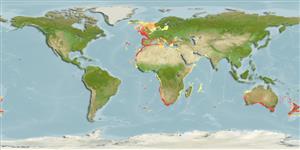>
Scombriformes (Mackerels) >
Trichiuridae (Cutlassfishes) > Lepidopodinae
Etymology: Lepidopus: Greek, lepis = scale + Greek, pous = foot (Ref. 45335).
Environment: milieu / climate zone / depth range / distribution range
Ecologia
marinhas bentopelágico; oceanódromo (Ref. 51243); intervalo de profundidade 42 - 620 m (Ref. 56504), usually 100 - 300 m (Ref. 6181). Deep-water; 64°N - 49°S, 29°W - 176°W (Ref. 6181)
Eastern Atlantic: France and western Mediterranean to Senegal, including Azores, Madeira, the Canary Islands and offshore seamounts; Cape Fria, Namibia to Agulhas Bank, South Africa including northern Walvis Ridge. Southern Indian Ocean: seamounts 30 to 35°S. Southwest Pacific: Australia (New South Wales to southern West Australia) and New Zealand. Southeast Pacific: Peru. A doubtful record from Cape San Lucas, Mexico.
Comprimento de primeira maturação / Tamanho / Peso / Idade
Maturity: Lm 111.0, range 92 - ? cm
Max length : 210 cm TL macho/indeterminado; (Ref. 36731); common length : 117 cm SL macho/indeterminado; (Ref. 6181); peso máx. publicado: 8.0 kg (Ref. 6181); idade máx. registrada: 8 anos (Ref. 117131)
Raios dorsais (total): 98-110; Espinhos anais 2; Raios anais : 59 - 66; Vértebras: 105 - 114. Second anal-fin spine plate-like. Pyloric caeca 20 - 29. Body uniformly silvery (Ref. 6181). Pelvic fin very small (Ref. 35388).
Occur on continental shelf, along its edge and upper slope down to 400 m (600 m in Australia), usually over sandy and muddy bottoms from 100 to 250 m (over 300 m in Australia). Depth range from 333-620 m in the eastern Ionian Sea (Ref. 56504). Migrate into midwater at night. Form schools; occasionally found inshore in upwelling of deep water when it appears at surface. Feed on crustaceans, small squid and fish (Ref. 6768). Eggs and larvae are pelagic (Ref. 6768).
Nakamura, I. and N.V. Parin, 1993. FAO Species Catalogue. Vol. 15. Snake mackerels and cutlassfishes of the world (families Gempylidae and Trichiuridae). An annotated and illustrated catalogue of the snake mackerels, snoeks, escolars, gemfishes, sackfishes, domine, oilfish, cutlassfishes,. scabbardfishes, hairtails, and frostfishes known to date. FAO Fish. Synop. 125(15):136 p. (Ref. 6181)
Status na Lista Vermelha da UICN (Ref. 130435)
Ameaça para os humanos
Harmless
Uso pelos humanos
Pescarias: altamente comercial; peixe esportivo: sim
Mais informação
ColaboradoresFotosStamps, Coins Misc.SonsCiguateraVelocidadeTipo de nataçãoÁrea branquialOtólitosCérebrosVisão
Ferramentas
Relatórios especiais
Baixar XML
Fontes da internet
Estimates based on models
Preferred temperature (Ref.
123201): 9.8 - 16, mean 12.1 °C (based on 330 cells).
Índice de diversidade filogenética (Ref.
82804): PD
50 = 0.5156 [Uniqueness, from 0.5 = low to 2.0 = high].
Bayesian length-weight: a=0.00041 (0.00032 - 0.00052), b=3.11 (3.04 - 3.18), in cm total length, based on LWR estimates for this species (Ref.
93245).
Nível Trófico (Ref.
69278): 3.8 ±0.3 se; based on diet studies.
Resiliência (Ref.
120179): médio(a), tempo mínimo de duplicação da população 1,4 - 4,4 anos (K=0.14-0.38; tmax=5-8).
Prior r = 0.41, 95% CL = 0.27 - 0.61, Based on 4 stock assessments.
Fishing Vulnerability (Ref.
59153): Moderate to high vulnerability (53 of 100).
Climate Vulnerability (Ref.
125649): Moderate vulnerability (38 of 100).
Nutrients (Ref.
124155): Calcium = 12.7 [5.3, 26.3] mg/100g; Iron = 0.278 [0.126, 0.619] mg/100g; Protein = 17.3 [15.6, 19.0] %; Omega3 = 0.219 [0.095, 0.529] g/100g; Selenium = 34.6 [12.2, 93.0] μg/100g; VitaminA = 4.17 [0.63, 22.13] μg/100g; Zinc = 0.279 [0.173, 0.476] mg/100g (wet weight); based on
nutrient studies.
